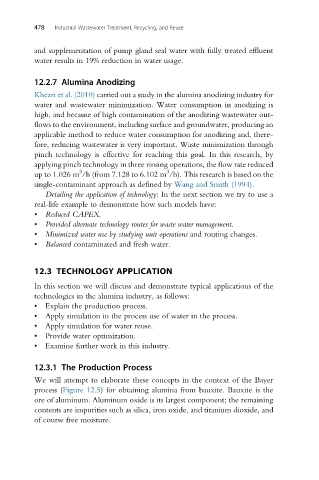Page 508 - Industrial Wastewater Treatment, Recycling and Reuse
P. 508
478 Industrial Wastewater Treatment, Recycling, and Reuse
and supplementation of pump gland seal water with fully treated effluent
water results in 19% reduction in water usage.
12.2.7 Alumina Anodizing
Khezri et al. (2010) carried out a study in the alumina anodizing industry for
water and wastewater minimization. Water consumption in anodizing is
high, and because of high contamination of the anodizing wastewater out-
flows to the environment, including surface and groundwater, producing an
applicable method to reduce water consumption for anodizing and, there-
fore, reducing wastewater is very important. Waste minimization through
pinch technology is effective for reaching this goal. In this research, by
applying pinch technology in three rinsing operations, the flow rate reduced
3
3
up to 1.026 m /h (from 7.128 to 6.102 m /h). This research is based on the
single-contaminant approach as defined by Wang and Smith (1994).
Detailing the application of technology: In the next section we try to use a
real-life example to demonstrate how such models have:
• Reduced CAPEX.
• Provided alternate technology routes for waste water management.
• Minimized water use by studying unit operations and routing changes.
• Balanced contaminated and fresh water.
12.3 TECHNOLOGY APPLICATION
In this section we will discuss and demonstrate typical applications of the
technologies in the alumina industry, as follows:
• Explain the production process.
• Apply simulation in the process use of water in the process.
• Apply simulation for water reuse.
• Provide water optimization.
• Examine further work in this industry.
12.3.1 The Production Process
We will attempt to elaborate these concepts in the context of the Bayer
process (Figure 12.5) for obtaining alumina from bauxite. Bauxite is the
ore of aluminum. Aluminum oxide is its largest component; the remaining
contents are impurities such as silica, iron oxide, and titanium dioxide, and
of course free moisture.

